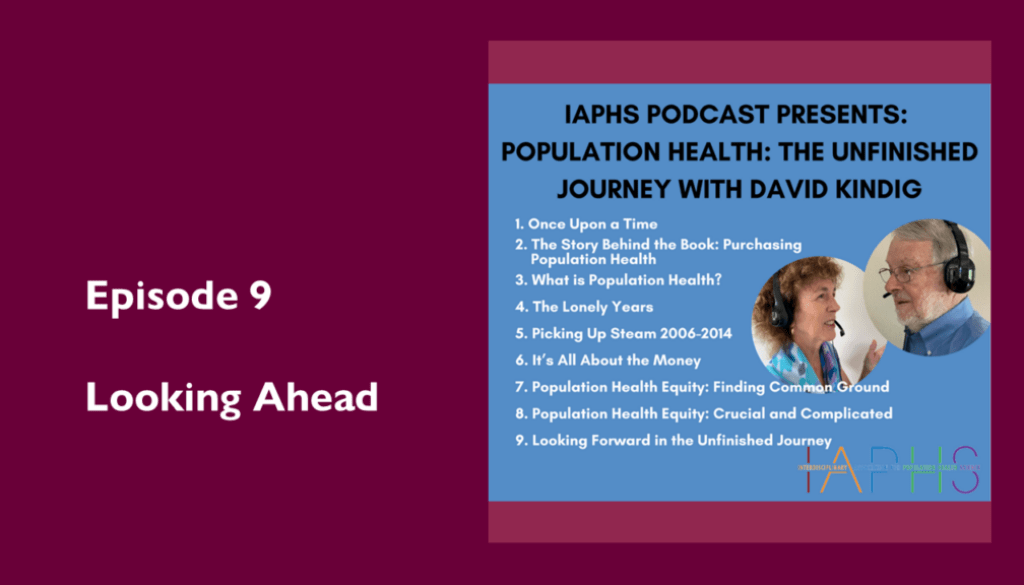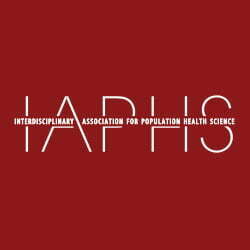Population Health – The Unfinished Journey with David Kindig: Episode 9, “Looking Ahead”
IAPHS Staff
In nine podcasts, David Kindig MD, PhD, a population health thought leader, is interviewed by Sanne Magnan MD, PhD about Kindig’s 50-year population health scholarly and policy journey, including many stories, anecdotes, and takeaways.
In our corresponding blog posts, we highlight some of the key moments and takeaways as a reminder for you to tune into previous and future podcasts. You can listen to Episode 1, “Once Upon a Time;” Episode 2, “The Story Behind the Book ‘Purchasing Population Health;’” Episode 3, “What Is Population Health?”; Episode 4, “The Lonely Years;” Episode 5, “Picking Up Steam;” Episode 6, “It’s All About the Money”; Episode 7, “Health Equity: Finding Common Ground,” and Episode 8, “Health Equity: Crucial and Complicated.”
Overview
In this final episode, Dave tells us what keeps him up at night and what a more finished journey in population health will look like. What will be our measures or benchmarks of success? He also discusses IOM recommendations and a general failure to deal with issues of equity and accountability. He explores resource allocation and how to balance investments across multiple determinants of health. He also highlights some of his favorite papers from his career.
Join us to discover the Final Takeaways from the podcast series Population Health: The Unfinished Journey with David Kindig.
Takeaways for Future Action/Goals in Population Health
- Advances in methodology and data quality have brought us closer to understanding how to balance the multiple determinants of health.
- Using this information, we can set per-capita investment benchmarks across determinants, with a sharp focus on raising the mean and closing gaps/improving equity.
- We can spend less in wasteful, unneeded healthcare and invest more in social determinants, especially with disadvantaged children.
- Financial formula model(s), like mortgage interest deductions or crop subsidies, are devised and implemented to drive these rebalanced investments.
- There are robust multisectoral health outcome trusts or community business model partnerships with adequate core funding to be effective.
- Political and ideological common ground and social solidarity can be built to make these five previous points sustainable.
References
- Kindig DA. 2015. Can there be political common ground for improving population health? Milbank Quarterly 93(1):24–27.
- Kindig DA. 2007. Understanding population health terminology. Milbank Quarterly 85(1):139-161.
- Kindig D, Nobles J, Zidan M. 2018. Meeting the Institute of Medicine’s 2030 US life expectancy target. American Journal of Public Health 108(1):87-92.
- McCullough JM, Speer M, Magnan S, Fielding JE, Kindig D, Teutsch SM. 2020. Reduction in US health care spending required to meet the Institute of Medicine’s 2030 target. American Journal of Public Health 110(12):1735-1740.
- Hughes-Cromwick P, Kindig D, Magnan S, Gourevitch M, Teutsch SM. 2021. The reallocationists versus the direct allocationists. Health Affairs Forefront. August 6.
- Kindig D. 2022. The promise of population health: a scenario for the next two decades. NAM Perspectives. Commentary, National Academy of Medicine. Washington, DC. https://doi.org/10.31478/202203a
- Kindig D. 2020. A Population Health Boot Camp. https://iaphs.org/a-population-health-boot-camp/
- Wagstaff A. 2002. Inequality aversion, health inequalities and health achievement. Journal of Health Economics 21(4):627–41. https://pubmed.ncbi.nlm.nih.gov/12146594/
- Kindig D. 2015. What are we talking about when we talk about population health? Health Affairs Blog, April 6.
- Kindig D. 2015. From health determinant benchmarks to health investment benchmarks. Preventing Chronic Disease 12:150010.
- Kindig DA, Isham G. 2014. Population health improvement: a community health business model that engages partners in all sectors. Frontiers in Health Services Management 30(4):3-20. This paper won the 2014 American College of Healthcare Executives (ACHE) Dean Conley Article of the Year Award.
- Kindig D. 2015. Can there be political common ground for improving population health? Milbank Quarterly 93(1):24–27.
- Kindig D. 2017. Population health equity: rate and burden, race and class. Journal of the American Medical Assocation 317(5):467-468.





All comments will be reviewed and posted if substantive and of general interest to IAPHS readers.